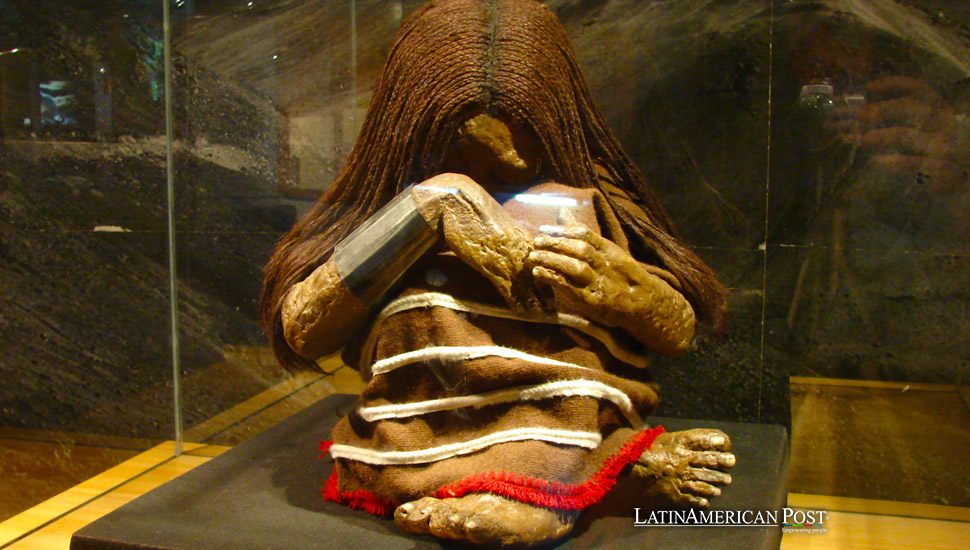The Violent End of Chilean Cerro El Plomo’s Incan Child

The discovery of the Plomo Mummy, an Incan child ritually sacrificed over 500 years ago on Chile’s Cerro El Plomo, revealed a shocking twist—this young boy did not die peacefully as once believed, but from a fatal blow to the head, challenging previous understandings of Incan rituals.
In 1954, archaeologists unearthed an astonishing find on the slopes of Cerro El Plomo in Chile—a well-preserved mummy of an Incan child, seated in a fetal position, his arms wrapped tightly around his knees. The child, who was approximately eight years old at the time of his death, became known as the “Plomo Mummy.” This discovery provided an invaluable glimpse into the Inca civilization and their sacrificial practices, particularly the ritual known as Qhapaq hucha, or Capacocha, in which children were sacrificed to appease the gods.
For decades, researchers believed that the child had been gently ushered into death. The prevailing theory suggested that he had been sedated with a potent narcotic, a common practice in Incan rituals, and left to succumb to the elements in his icy tomb. His final moments, it was assumed, were peaceful—marked by hypothermia and the gradual fading of life as the cold overtook him. The preservation of his body in the frozen Andes provided a haunting yet serene image of an ancient rite, one that seemed to exemplify the Inca’s reverence for the deities they worshiped.
New Insights into an Ancient Sacrifice
However, a recent study has upended these long-held beliefs. Using advanced imaging techniques, researchers have discovered that the child did not die as peacefully as previously thought. Instead, the evidence now suggests that his life was violently cut short by a blow to the head, likely inflicted by one of the attendants at the sacrificial ceremony. This revelation adds a new layer of complexity to our understanding of Incan sacrificial practices and raises questions about the nature of such rituals.
The study, conducted by a team of archaeologists and forensic experts, utilized modern technology to re-examine the Plomo Mummy. By analyzing the structure of the child’s skull, they identified fractures consistent with blunt force trauma. These findings indicate that the boy’s death was not solely the result of hypothermia, as initially believed, but was likely caused by a deliberate act of violence. This discovery suggests that the ritual of Qhapaq hucha may have involved more direct and brutal methods of sacrifice than previously documented.
The Long Journey to Cerro El Plomo
Before his tragic end, the child is believed to have undertaken a grueling journey from south-central Peru to Cerro El Plomo, covering a distance of over 2,000 kilometers (1,250 miles). The marks found on his feet indicate that the trek was arduous, with the boy likely enduring months of travel through varied and often harsh landscapes. This journey would have been physically and mentally taxing, pushing the child to the limits of endurance.
The journey to Cerro El Plomo was not merely a test of endurance but a pilgrimage laden with religious significance. The child, who may have been chosen for his physical beauty or social status, was destined to become a bridge between the mortal world and the divine. As he walked, he was accompanied by priests and officials, all of whom were aware of the fate that awaited him at the end of the journey. This pilgrimage was a symbolic enactment of the boy’s transition from the earthly realm to the spiritual plane, a process that was to culminate in his sacrifice.
A New Perspective on Incan Sacrificial Rites
The revelation that the Plomo Mummy died from a blow to the head rather than peaceful hypothermia offers new insights into the nature of Incan sacrificial rites. The Qhapaq hucha ritual, as practiced by the Inca, was a complex and multifaceted event, deeply embedded in the religious and political fabric of the empire. It was believed that by offering the lives of the most pure and innocent, the Inca could secure divine favor, ensuring the well-being and prosperity of their people.
However, the violent nature of the child’s death challenges the notion that these sacrifices were solely acts of religious devotion. Instead, it suggests that they may have also served as displays of power and control, both over the chosen victims and the population at large. The decision to end the boy’s life with a blow to the head rather than allowing him to die from the cold may have been intended to assert the authority of the Inca leaders and the inevitability of their divine will.
Additionally, the placement of ceremonial objects, such as the figures of camelids made of precious materials, next to the boy’s body indicates the importance of the sacrificial ritual in the eyes of the Inca. These offerings were not merely tokens of respect for the deceased but were believed to accompany the child on his journey to the afterlife, where he would serve the gods.
Also read: Chile’s Scientific Achievements Leads to Hosting Major Astronomical Assembly
The Plomo Mummy, once thought to represent a peaceful transition from life to death, now reveals a more unsettling truth about the Inca’s sacrificial practices. The discovery that this young boy met a violent end challenges previous perceptions and underscores the complexity of ancient rituals. As researchers continue to study the Plomo Mummy and other sacrificial victims, our understanding of the Inca civilization will undoubtedly evolve, revealing new facets of this enigmatic culture. The Plomo Mummy stands as a poignant reminder of the lengths to which the Inca went to appease their gods and the tragic human cost of their devotion.





